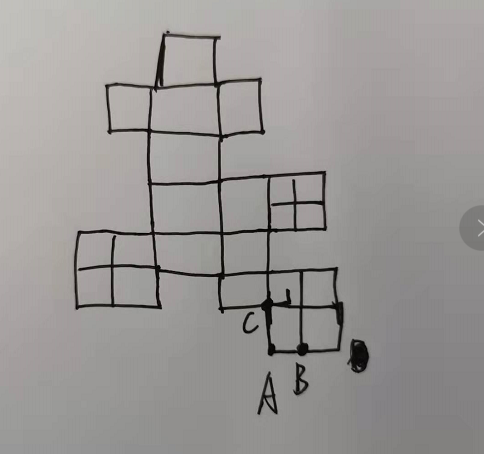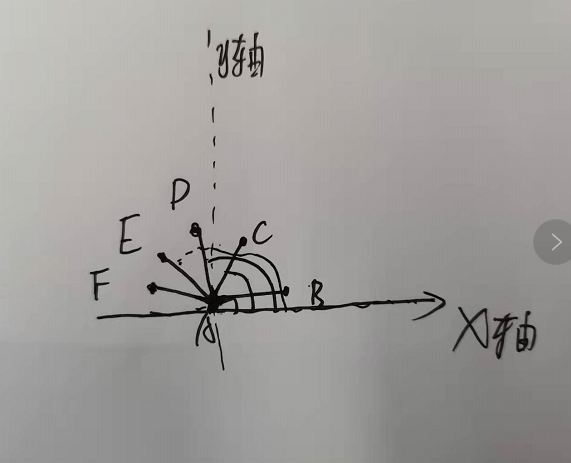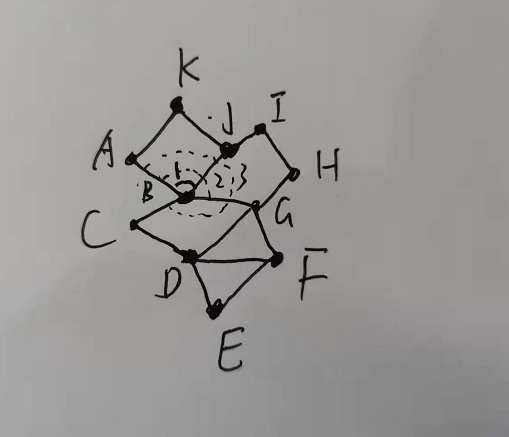求闭合区域的最外围的线段思路
1.找起始点:获取所有的点,找到最左下点(A)点。很关键的点
2.找起始边:首先用邻接链表存储所有点边之间的关系。找到第一条最外围的线段,根据极角来找最外围的线段,注意A是最左下角,所以上面所有连接它的线段和水平角度不会超过180度。以x轴正方向作为向量(1,0),其他向量和它做角度差,用点积求角度。可以找出AB线段。
3.找所有外边:通过角度差找最外边。如已经知道第一条外边AB边了,现在对B连接的BJ、BG、BC判断哪一条是接下来的边。通过向量叉积和点积方法,点积只能计算0到180度,无法计算超过180度,这时候利用到叉积,由于我们选的点在左下角,最后找外围线只会逆时针查找,A-B-C-D-E-F-G-H-I-J-K-A。所以0到180度的时候叉积为负,超过180度叉积为正,根据这个去计算其他边AB边的角度,角度最大就是最外边。最终会找到原点A。这样就能找到所有的最外边。
//去重
//节点去重
void CubeExportYJKHelper::GetUniquePoints(const vector<iCoord3d>& ptSets, vector<iCoord3d>& needPts)
{
for (const iCoord3d& pt : ptSets)
{
bool exist = false;
for (const iCoord3d& ic3d : needPts)
{
if (abs(ic3d[0] - pt[0]) < TOLERANCE && abs(ic3d[1] - pt[1]) < TOLERANCE)
{
exist = true;
break;
}
}
if (!exist)
needPts.push_back(pt);
}
}
//获取最左下角的点
void CubeExportYJKHelper::GetLeftDownPointFromPtSet(const vector<vector<pair<iCoord2d, iCoord2d>>> &areas,vector<iCoord3d> &needPts)
{
vector<iCoord3d> points;
//将点提取出来存储,里面会有几个重复的点
for (const auto &var : areas)
{
for_each(var.begin(), var.end(), [&](const pair<iCoord2d, iCoord2d> &pt)
{
points.emplace_back(Pt2dTo3d(YJKiCoord2d(pt.first),0));
});
}
//去重
GetUniquePoints(points, needPts);
//对点进行排序,得到第一个最下点
std::sort(needPts.begin(), needPts.end(), [](const iCoord3d &fpt, const iCoord3d &spt) {
//y轴相同
if (fpt[1] == spt[1])
return fpt[0] < spt[0];
else
return fpt[1] < spt[1];
});
}
//获取最外围的线
void CubeExportYJKHelper::GetOutsideLines(const AdjacentListGraph &graph,const int &origin,iVec2d &vec,set<int> & outsideId,
pair<int, int> &lable,bool &tag)
{
headLNode headNode = graph.node[lable.first];
shared_ptr<arcLNode> tempPt = headNode.firstarc;
//记录点的位置
int ptAdjvec;
//判断点积
double angle = 0;
//线的id
int lineId = -1;
//获取当前点关联的所有其他点
while (tempPt)
{
//如果连接起始点就结束
if (tempPt->adjvex == lable.second)
{
tempPt = tempPt->nextarc;
continue;
}
headLNode otherNode = graph.node[tempPt->adjvex];
iVec2d tempVec(otherNode.point[0] - headNode.point[0], otherNode.point[1] - headNode.point[1]);
//先求两向量叉积,判断角度是否超过180度,由于逆时针找线,所以叉积为负,角度在0到180度,为正角度为180到360
double crossA = vec.SignZCross(tempVec);
//如果小于0
if (crossA<=0)
{
//求点积
double dotA = vec.Dot(tempVec);
//求角度
double mAngle = acos(dotA / (vec.Length() * tempVec.Length()))*180/PI;
if (mAngle > angle)
{
angle = mAngle;
ptAdjvec = tempPt->adjvex;
lineId = tempPt->lineId;
}
}
else
{
//求点积
double dotA = vec.Dot(tempVec);
//求角度
double mAngle = 360 - acos(dotA / (vec.Length() * tempVec.Length())) * 180 / PI;
if (mAngle > angle)
{
angle = mAngle;
ptAdjvec = tempPt->adjvex;
lineId = tempPt->lineId;
}
}
tempPt = tempPt->nextarc;
continue;
}
//如果最终点是起始点,标记为真,结束循环,找到所有的外围线
if (ptAdjvec == origin)
{
outsideId.insert(lineId);
tag =true;
}
else
{
vec = iVec2d(headNode.point[0] - graph.node[ptAdjvec].point[0],
headNode.point[1] - graph.node[ptAdjvec].point[1]);
outsideId.insert(lineId);
lable = pair<int, int>(ptAdjvec, lable.first);
}
}
//传入线段集合,获取最外围线段
void CubeExportYJKHelper::GetOutsideLinesFromLineSet(const vector<SegmentLine> &lines,
const vector<iCoord3d> & points,
const iCoord3d & startPt,
vector<SegmentLine> & outside)
{
//创建邻接链表
AdjacentListGraph graph;
graph.edgeNum = static_cast<int>(lines.size());
graph.vertexNum = static_cast<int>(points.size());
//存储点
for_each(points.begin(), points.end(), [&](const iCoord3d points) {
headLNode hNode(points);
graph.node.emplace_back(hNode);
});
//存储起始点在邻接表的位置
int originNum(0);
//存储边的信息
for (const SegmentLine&line:lines)
{
//获取边的两个端点
vector<iCoord3d> icPt {line.startPt, line.endPt, startPt};
vector<int> nums;
for (const iCoord3d&pt:icPt)
{
for (int i = 0; i < graph.vertexNum; ++i)
{
//如果两个点的距离大于1就不是同一个点
if (pt.DistPtPt(graph.node[i].point) > 1)
continue;
nums.emplace_back(i);
break;
}
}
iCoord3d sPt(line.startPt), ePt(line.endPt);
//获取两个点的位置
int sNum(nums[0]), eNum(nums[1]);
originNum = nums[2];
//如果第一点为空
if (!graph.node[sNum].firstarc)
{
std::shared_ptr<arcLNode> arcNode(new arcLNode());
arcNode->adjvex = eNum;
arcNode->lineId = line.id;
graph.node[sNum].firstarc = std::move(arcNode);
}
else
{
std::shared_ptr<arcLNode> tempNode = graph.node[sNum].firstarc;
//找到最后一个节点
while (tempNode->nextarc)
tempNode = tempNode->nextarc;
std::shared_ptr<arcLNode> arcNode(new arcLNode());
arcNode->adjvex = eNum;
arcNode->lineId = line.id;
tempNode->nextarc = std::move(arcNode);
}
if (!graph.node[eNum].firstarc)
{
std::shared_ptr<arcLNode> arcNode(new arcLNode());
arcNode->adjvex = sNum;
arcNode->lineId = line.id;
graph.node[eNum].firstarc = std::move(arcNode);
}
else
{
std::shared_ptr<arcLNode> tempNode = graph.node[eNum].firstarc;
//找到最后一个节点
while (tempNode->nextarc)
tempNode = tempNode->nextarc;
std::shared_ptr<arcLNode> arcNode(new arcLNode());
arcNode->adjvex = sNum;
arcNode->lineId = line.id;
tempNode->nextarc = std::move(arcNode);
}
}
//最外围起始点开始查询,利用和邻边角度差求最外围线
//找最外边,通过极角方法找最外边
headLNode originPt = graph.node[originNum];
//记录当前点所有关联的点形成的线段
vector<tuple<iCoord3d, int,int>> anglePt;
shared_ptr<arcLNode> tempPt = originPt.firstarc;
//记录点的位置
vector<int> ptAdjvec;
//获取当前点关联的所有其他点
while (tempPt)
{
anglePt.emplace_back(tuple<iCoord3d, int, int>(graph.node[tempPt->adjvex].point, tempPt->adjvex,tempPt->lineId));
tempPt = tempPt->nextarc;
}
double minAngle = 360;
int label = -1;
int lineId = -1;
iCoord3d point = originPt.point;
//最小极角就是最外边
for_each(anglePt.begin(), anglePt.end(), [&](const tuple<iCoord3d, int,int> pt)
{
iVec2d vec(get<0>(pt)[0] - point[0], get<0>(pt)[1] - point[1]);
//向量和x轴正方向进行比较
double angle = vec.Dot(iVec2d(1,0));
double mAngle = acos(angle / (vec.Length() * iVec2d(1, 0).Length())) * 180 / PI;
//如果小,记录那个点
if (mAngle < minAngle)
{
minAngle = mAngle;
label = get<1>(pt);
lineId = get<2>(pt);
}
});
//对起始点和起始边的另一点的访问记录
graph.node[originNum].visited = true;
graph.node[label].visited = true;
//以这条边去判断最外围的边
bool endSearch = false;
//c存第一条边的id
set<int> outsideId{lineId};
//第二个点
iCoord3d sPt = graph.node[label].point;
iVec2d vec(point[0]-sPt[0],point[1]-sPt[1]);
//存点编号,a指向b
pair<int, int> vecLabel(label, originNum);
//找到最外围的线,存线的id即可
while (!endSearch)
GetOutsideLines(graph, originNum, vec, outsideId, vecLabel, endSearch);
//处理最外围的线,去查找
for (const int& var:outsideId)
{
for (const SegmentLine &mLine:lines)
{
if (var != mLine.id) continue;
outside.emplace_back(mLine);
break;
}
}
}今天的文章如何闭合线段_线段差的最大值的原理分享到此就结束了,感谢您的阅读。
版权声明:本文内容由互联网用户自发贡献,该文观点仅代表作者本人。本站仅提供信息存储空间服务,不拥有所有权,不承担相关法律责任。如发现本站有涉嫌侵权/违法违规的内容, 请发送邮件至 举报,一经查实,本站将立刻删除。
如需转载请保留出处:http://bianchenghao.cn/78932.html



